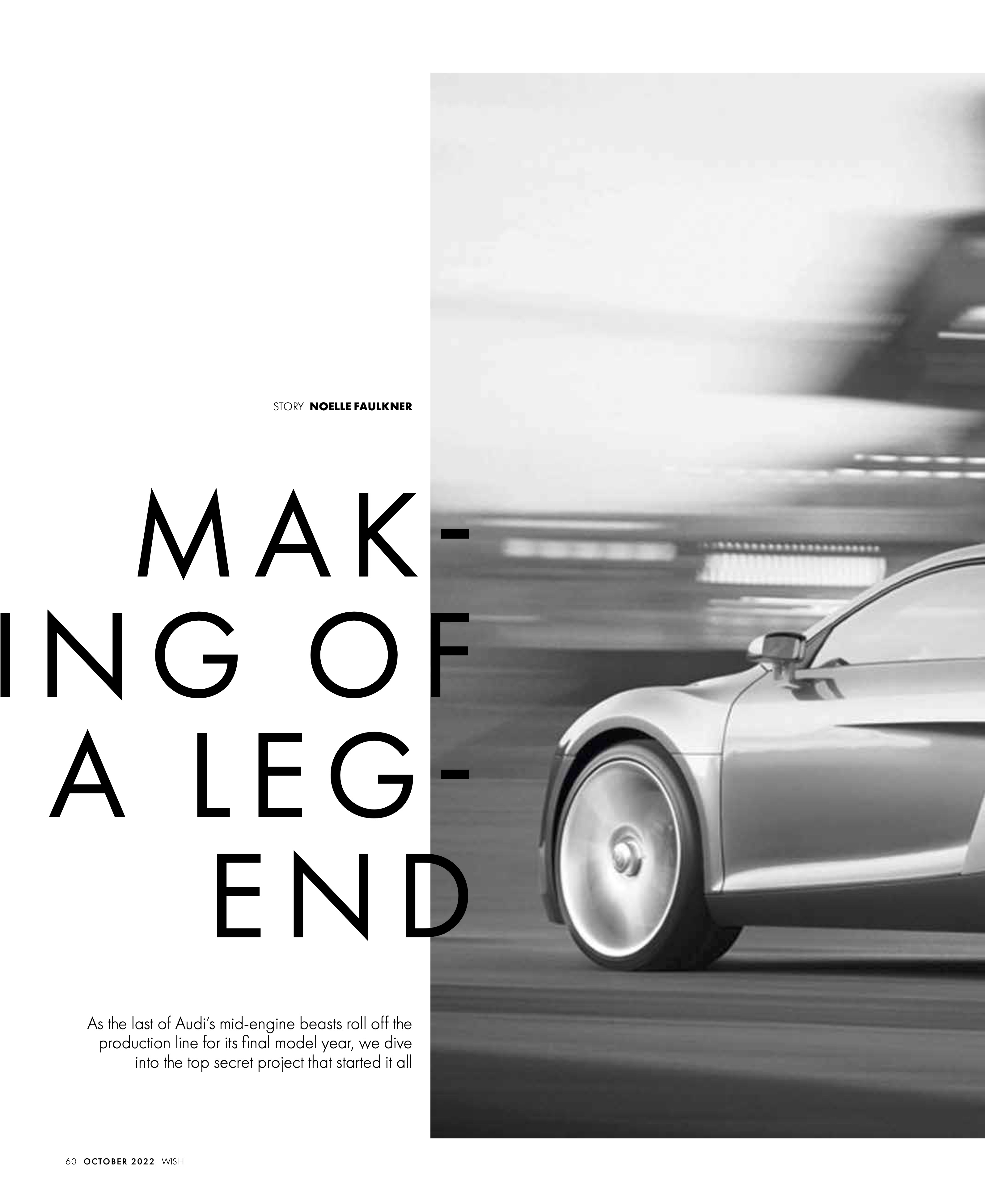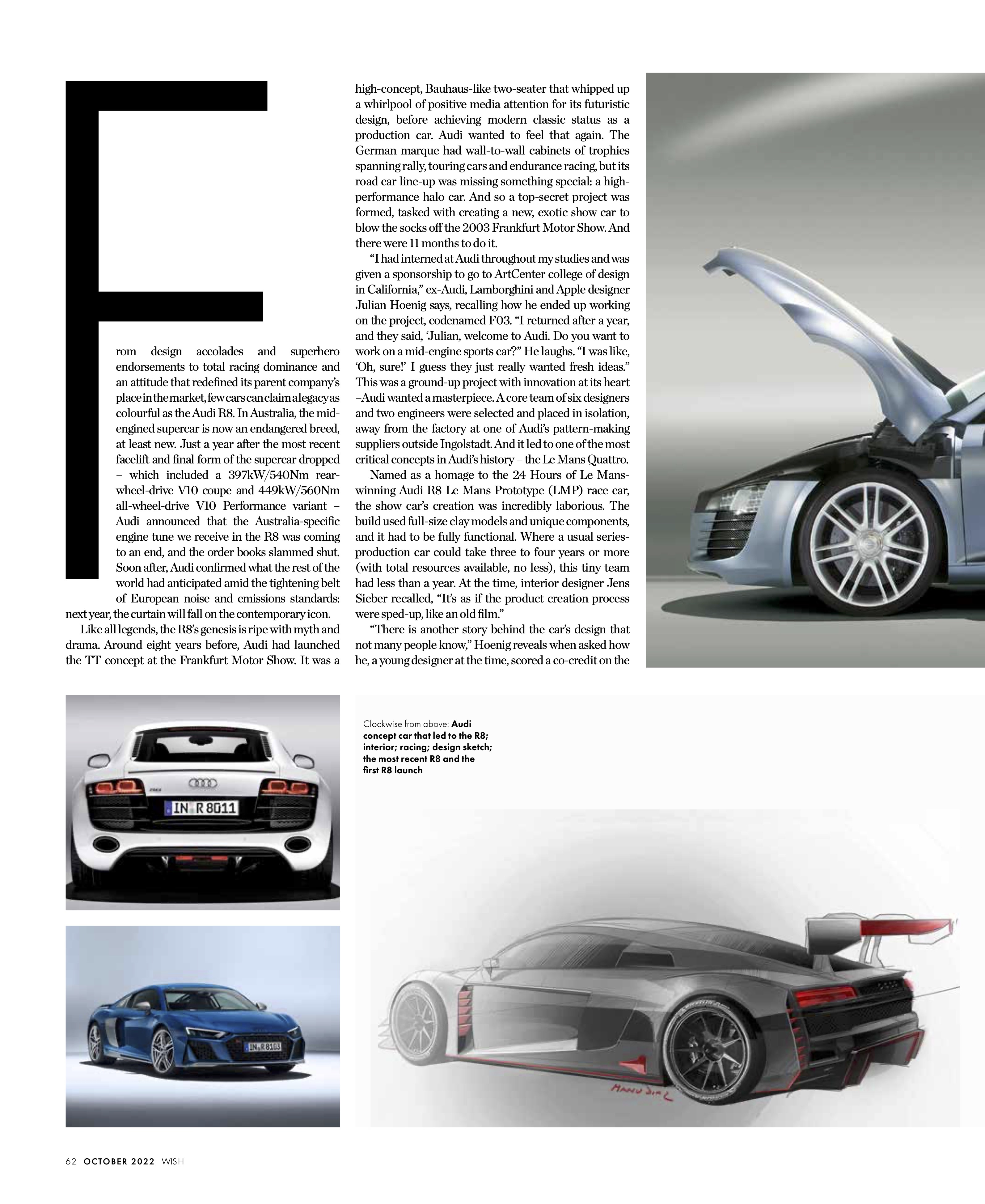Audi R8: Making of a Legend
As the last of Audi’s mid-engine beasts roll off the production line for its final model year, we dive into the top secret project that started it all
The Australian, Wish Magazine; 2021 (PDF) (LINK)

From design accolades and superhero endorsements to total racing dominance and an attitude that redefined its parent company’s place in the market, few cars can claim a legacy as colourful as the Audi R8. In Australia, the mid- engined supercar is now an endangered breed, at least new. Just a year after the most recent facelift and final form of the supercar dropped – which included a 397kW/540Nm rear- wheel-drive V10 coupe and 449kW/560Nm all-wheel-drive V10 Performance variant – Audi announced that the Australia-specific engine tune we receive in the R8 was coming to an end, and the order books slammed shut. Soon after, Audi confirmed what the rest of the world had anticipated amid the tightening belt of European noise and emissions standards:
next year, the curtain will fall on the contemporary icon. Like all legends, the R8’s genesis is ripe with myth and drama. Around eight years before, Audi had launched the TT concept at the Frankfurt Motor Show. It was a high-concept, Bauhaus-like two-seater that whipped up a whirlpool of positive media attention for its futuristic design, before achieving modern classic status as a production car. Audi wanted to feel that again. The German marque had wall-to-wall cabinets of trophies spanning rally, touring cars and endurance racing, but its road car line-up was missing something special: a high- performance halo car. And so a top-secret project was formed, tasked with creating a new, exotic show car to blow the socks off the 2003 Frankfurt Motor Show. And there were 11 months to do it.
“I had interned at Audi throughout my studies and was given a sponsorship to go to ArtCenter college of design in California,” ex-Audi, Lamborghini and Apple designer Julian Hoenig says, recalling how he ended up working on the project, codenamed F03. “I returned after a year, and they said, ‘Julian, welcome to Audi. Do you want to work on a mid-engine sports car?” He laughs. “I was like, ‘Oh, sure!’ I guess they just really wanted fresh ideas.” This was a ground-up project with innovation at its heart –Audi wanted a masterpiece. A core team of six designers and two engineers were selected and placed in isolation, away from the factory at one of Audi’s pattern-making suppliers outside Ingolstadt. And it led to one of the most critical concepts in Audi’s history – the Le Mans Quattro.
Named as a homage to the 24 Hours of Le Mans- winning Audi R8 Le Mans Prototype (LMP) race car, the show car’s creation was incredibly laborious. The build used full-size clay models and unique components, and it had to be fully functional. Where a usual series- production car could take three to four years or more (with total resources available, no less), this tiny team had less than a year. At the time, interior designer Jens Sieber recalled, “It’s as if the product creation process were sped-up, like an old film.”
“There is another story behind the car’s design that not many people know,” Hoenig reveals when asked how he, a young designer at the time, scored a co-credit on the concept alongside lead exterior designer Frank Lamberty. “It was because of the Audi RSQ, the movie car in iRobot.” Audi was approached to create a car for the sci-fi film, and Hoenig’s design, which was especially futuristic, was offered up for the role by the design boss, Walter de Silva. It turns out, without the iRobot commission, the R8 would have looked a lot different. “Long story short, I did an alternative rear design for the movie car, which the bosses liked and later became the rear of the show car.”
In 2003, the two-door coupe debuted in Frankfurt, outdoing the fanfare of the TT. “I cannot imagine what Mercedes or BMW were thinking when they saw it,” laughs Hoenig. “They would have been like, ‘oh my god!’” A 449kW/750Nm, 5.0-litre twin-turbo V10 engine (developed from the Lamborghini Gallardo) with petrol direct injection and new technologies, including an aluminium space frame (also Gallardo-shared) with carbon-fibre reinforced exterior, Audi magnetic ride suspension, full LED headlights and digital cockpit display? It would have been a shock. Audi had to put it into production – how could it not? The Le Mans Quattro set the tone for what we see today.
Three years later, a road-devouring, mid-engined legend was revealed, first with a 309kW/430Nm 4.2 L V8 that could hit 0-100km/h in 4.6 seconds and had a top speed of 301km/h; then later, a 391kW/ 530Nm 5.2L V10, developed from the Lamborghini Gallardo. The R8 caused a sensation, earning Audi a place at the table of top-tier high-performance marques and cementing its reputation as an innovator. “The R8 pushed the brand forwards, not just up,” says Hoenig. “Mercedes-Benz and BMW didn’t have anything comparable, and they still don’t.”
In 2008, another film deal offered the R8 the billionaire superhero stamp of approval when it was featured in Iron Man as Tony Stark’s daily driver; pushing its notoriety beyond automotive circles and into pop culture, fast- tracking its poster car status for the teens of the 2000s – an important rite of passage towards icon status. What also contributed is the R8’s design, which was ahead of its time. Its futuristic and athletic-clean exterior aesthetic and innovative cockpit echoed the broader zeitgeist simmering
in technology, fashion, design, architecture and culture, which still exists today. Hoenig, who spent a decade as a designer at Apple after automotive, agrees: “What I think was so fantastic about the R8 is it’s approachable. Yes, it’s an expensive sports car, and it might have had the same engine as a Lamborghini, but it’s subtle and doesn’t get the same attitude that a Lamborghini would get, you know?” He adds, “It still turns heads, and it has a modern elegance that not many other cars have.”
Without the R8 road car, Audi Sport would not be the motorsport powerhouse it is today, where homologated R8s dominate around the world, from GT to endurance racing. The success is remarkable – take the R8 LMS race car, its V10 engine almost wholly based on the road car’s, for example; it’s earned six overall wins at the 24-hours- of Nürburgring in 10 years, making it the most successful modern manufacturer in the race. To get here, Audi Sport moved fast. It was only a few years after the R8’s reveal, in 2009, when its customer racing program was introduced, allowing customers to race the R8 in GT3 worldwide. Other OEMs quickly took note. “Audi was doing it as a customer program so our customers could go racing at the highest level,” says Shaun Clearly, Audi Australia’s Corporate Communications Officer. “While most brands are now doing something similar, Audi was the only one to do it in the way that your entire program, from parts to service, support and car, was highly developed. The R8 was the innovator in that space for us.” He adds, “It has come a long, long way in a short period.”
The Australian appetite for the R8 has been insatiable, with almost 700 sold, spanning two generations and the entire range of coupes, spyders, V8s, V10s, all-wheel-drive and rear-wheel-drive variants. While there is one last place you can experience the car, at least until the end of the year, at one of Audi’s Sport Pro Driving Experience track days, its departure leaves a hole in many enthusiasts’ hearts. So what’snext? The board’s line is that something special, and of course electrified, is coming, but what the successor will look like is again under strict secrecy. However, Pierre Kaffer, Audi Sport race driver and Nürburgring 24 Hours and 24 Hours of Le Mans winner, who worked with the development of the R8, left us one hint – Audi hopes to repeat history, and it won’t be boring. “When the first R8 came out we said we wanted to create history,” he says. “Now, it’s done. But we have to keep moving forward. The next project will maybe create another moment, with, again, a new vision for the future.”



